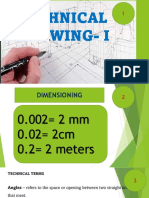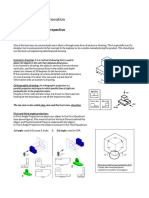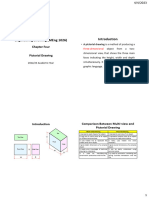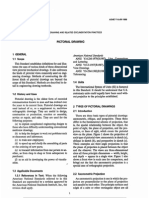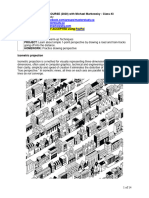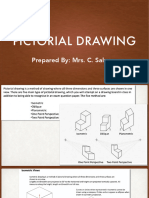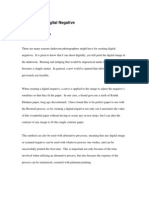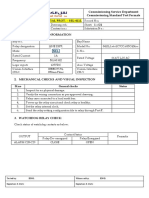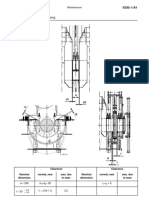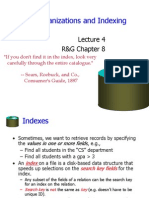Pictorial Drawing Tle 10
Uploaded by
Leiyoh RectoPictorial Drawing Tle 10
Uploaded by
Leiyoh RectoPICTORIAL
DRAWING
PICTORIAL DRAWING
A pictorial drawing is an image of an object
(actual or imagined) viewed as it would be
seen by someone who looks at the object
either in a chosen direction or from a
selected point of view. Pictorial drawings or
sketches often are more readily made and
more clearly understood than are orthogonal
drawings.
PICTORIAL DRAWING
• Pictorial drawings are important elements of
working drawing because they show the graphic
representation of an object as it appears on the
observer’s eyes.
• Even a person who has no technical knowledge
in technical drawing, can easily understand the
object being presented in the drawing.
Three Types of Pictorial
Projection
• Axonometric- projection
• Oblique pictorial drawing
• Perspective pictorial
drawing
• Axonometric- projection
“Axonometric” means
“to measure along
axes”. Axonometric
projection shows an
image of an object as
viewed from a skew
direction in order to
reveal more than one
side in the same picture.
Kinds of Axonometric Projection
Isometric pictorial
projection
Dimetric pictorial
projection
Trimetric pictorial
projection
Isometric Pictorial Projection
The most commonly
used form of
axonometric projection
in engineering drawing.
Here all three angles are
equal. The isometric is
the least pleasing to the
eye, but is the easiest to
draw and dimension.
Dimetric Pictorial Projection
When two of the three
angles are equal, the
drawing is classified as
a dimetric projection.
Dimetric drawings are
less pleasing to the eye,
but are easier to
produce than trimetric
drawings.
Trimetric Pictorial Projection
The direction of viewing is
such that all of the three
axes of space appear
unequally foreshortened.
The scale along each of the
three axes and the angles
among them are determined
separately as dictated by
the angle of viewing.
• Oblique Pictorials
An Oblique pictorial starts
with a straight-on view of
one of the object’s faces,
which is often the front
face. Angled, parallel lines
are drawn to one side to
represent the object’s
depth. The most common
oblique angle is 45°. But
30°and 60° is used also.
Kinds of Oblique Pictorial Drawing
• Cavalier-refers to
measurements of
width, height and
depth/ length in full
size
• General- refers to
measurements of
width, and height
are full size while
its depth or length
is two third
• Cabinet- refers to
measurements of
width and height
in full size while
its depth or length
is one half
• Perspective pictorial drawing
A Perspective drawing is one of
the best types of drawings to use
to provide a pictorial
representation of an object. They
produce an image of an object in
three dimensions that is very
similar to what the human eye
sees. Perspective drawings can be
in one point, two point or three
point perspective.
Types of Perspective
Pictorial Drawing
• One Point Perspective
• Two Point Perspective
• Three Point Perspective
One Point Perspective
One point perspective is a type
of linear perspective. Linear
perspective relies on the use of
lines to render objects leading
to the illusion of space and
form in a flat work of art. It is a
structured approach to
drawing. One point perspective
gets its name from the fact that
it utilizes a single vanishing
point.
HORIZON AND VANISHING POINT
• The Horizon
One point perspective assumes that a viewer
is at a certain vantage point and that there is
a real or theoretical "horizon line" present.
The "horizon line" is sometimes described
as the line that divides the ground from the
sky.
• The Vanishing Point
Dots placed on the horizon are called the
"vanishing points". One point perspective
utilizes one vanishing point. All of the lines of
perspective will recede back to this singular dot
in space. This dot can best be thought of as the
place where objects begin to disappear because
of distance. Some of the lines used in one point
perspective will use the "vanishing point" as an
anchor.
One point perspective is not
limited to basic forms and
buildings. It can also be used
to draw interiors using the
same approach. A horizon line
is defined, although it most
likely will not be visible in the
finished drawing. A vanishing
point is placed on the horizon
line, before basics shapes are
drawn.
Two Point Perspective
Two point perspective
drawing is a type of linear
perspective. Linear
perspective is a method
using lines to create the
illusion of space on a 2D
surface. Two point
perspective uses two
points placed on the
horizon line.
Once the horizon line has been
established, the vanishing points are
placed. The vanishing point is defined
as a point placed on the horizon line
where objects begin to disappear
because of distance. A good way to
think of the vanishing point is by
imagining yourself standing on a beach.
Looking both directions, you can see
endlessly down the beach. At some
point, people on the beach walking away
from you will become progressively
smaller until they completely disappear
at the horizon line.
Three Point Perspective
Three point perspective
uses three vanishing points.
The third vanishing point in
three point perspective is
not placed on the horizon
line as seen with two point
and one point perspective.
Instead the third vanishing
point is placed under or
above the horizon line.
MAN’S EYE VIEW
Man's Eye view is the
view which aligned in
a human's eye.
It is the actual height
of the viewer's eyes
when looking at an
object, interior scene,
or an exterior scene.
WORMS EYE VIEW
A worm's-eye view is
a view of an object
from below, as
though the observer
were a worm; it is the
opposite of a bird's-
eye view.
BIRDS EYE VIEW
A bird's-eye view is an elevated
view of an object or location from
a very steep viewing angle,
creating a perspective as if the
observer were a bird in flight
looking downwards. Bird's-eye
views can be an aerial
photograph, but also a drawing,
and are often used in the making
of blueprints, floor plans and
maps.
Isometric
Pictorial
Drawing
1. Prepare the following tools and
materials
- T-square -
Compass
- Pencil -
Technical pen
- Drawing paper - Eraser
- Masking tape
You might also like
- Schedule of Doors 1: D-1 D-2 D-3 D-4 D-5 D-6No ratings yetSchedule of Doors 1: D-1 D-2 D-3 D-4 D-5 D-61 page
- Aquatic Center: Procurement Status of Long Lead ItemsNo ratings yetAquatic Center: Procurement Status of Long Lead Items4 pages
- Drafting Q2-L2 Engineering Drawing and SketchingNo ratings yetDrafting Q2-L2 Engineering Drawing and Sketching7 pages
- Class XI - Technical Drawing & PerspectiveNo ratings yetClass XI - Technical Drawing & Perspective4 pages
- 03D - Methods of Drawing Representation (Pictorial)No ratings yet03D - Methods of Drawing Representation (Pictorial)24 pages
- Pictorial Drawing: Ivan T. Dolleson Instructor 1No ratings yetPictorial Drawing: Ivan T. Dolleson Instructor 147 pages
- Reading Material (Perspective Drawings)No ratings yetReading Material (Perspective Drawings)10 pages
- Drafting Technology 8 Reviewer Shortbondpaper100% (2)Drafting Technology 8 Reviewer Shortbondpaper3 pages
- Unit+3 +Visualization+and+Representation+INo ratings yetUnit+3 +Visualization+and+Representation+I29 pages
- Beginner's Drawing Course (2020) With Michael Markowsky - Class #3-SmallNo ratings yetBeginner's Drawing Course (2020) With Michael Markowsky - Class #3-Small14 pages
- Theory of Principle of Orthographic ProjectionNo ratings yetTheory of Principle of Orthographic Projection30 pages
- Lesson 4 Prepare and Interpret Technical Drawing: Alphabet of LinesNo ratings yetLesson 4 Prepare and Interpret Technical Drawing: Alphabet of Lines26 pages
- TLE-ModifiedGR9 Q2 W1-2 Mod1 TECHNICAL-DRAFTINGNo ratings yetTLE-ModifiedGR9 Q2 W1-2 Mod1 TECHNICAL-DRAFTING18 pages
- Perspective Drawing: Waweru Hannah Nyakio B02/53847/2012No ratings yetPerspective Drawing: Waweru Hannah Nyakio B02/53847/201211 pages
- Tech. Draw. Module 12 Q4 WK 5 8 Jaa JCR 1No ratings yetTech. Draw. Module 12 Q4 WK 5 8 Jaa JCR 128 pages
- Modflow - Conceptual Model Approach 2: GMS 10.4 TutorialNo ratings yetModflow - Conceptual Model Approach 2: GMS 10.4 Tutorial13 pages
- Welding Metallurgy and Weldability of Stainless SteelsNo ratings yetWelding Metallurgy and Weldability of Stainless Steels7 pages
- Live 360 Getting Started Guide July PDFNo ratings yetLive 360 Getting Started Guide July PDF23 pages
- Graduate School Examination - Computer ScienceNo ratings yetGraduate School Examination - Computer Science12 pages
- Seismic Fragility Assessment of ElevatedNo ratings yetSeismic Fragility Assessment of Elevated10 pages
- Quiz-W02-Operator, Control Flow & Looping - Attempt ReviewNo ratings yetQuiz-W02-Operator, Control Flow & Looping - Attempt Review1 page
- Causes (Curling, Buckling and Fractured)No ratings yetCauses (Curling, Buckling and Fractured)5 pages
- File Organizations and Indexing: R&G Chapter 8No ratings yetFile Organizations and Indexing: R&G Chapter 840 pages








